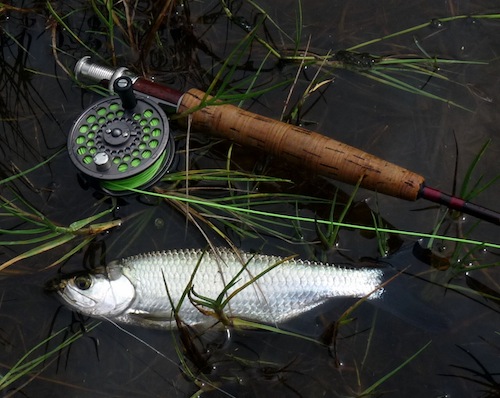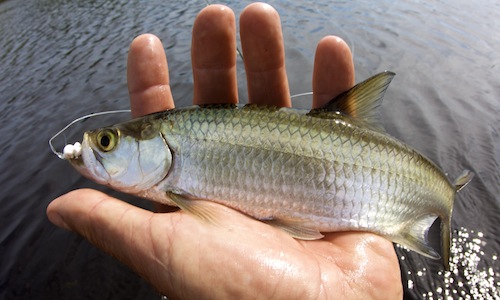A Guest Blog by Paul MacInnis
Paul MacInnis is an engineer and an award winning outdoor writer who serves on the board of directors for Anglers for Conservation. He is a family man dedicated to his lovely wife Nancy and two wonderful daughters, Anna and Lily.

Tiny Tarpon like this one can be caught in many roadside ditches throughout Florida. Photo courtesy of Paul MacInnis.
Last week I stood beside Hall Road in Merritt Island. Using my four weight more like a cane pole than a fly rod, I swam a number eight streamer around clumps of grass and an old log. Flashy little fish attacked my fly like a horde of hungry ladyfish. But these were no ladyfish; they were tiny tarpon five to ten inches long.
How did these tiny tarpon get to this roadside ditch among the cattails, gar and mosquitoefish? Theirs was an epic, perilous journey spanning perhaps hundreds of miles. Just for them to make it to this rural roadside canal in east central Florida, miles from saltwater, borders on the impossible.
It likely starts in the deep ocean sometime between April and August. Scientists believe adult tarpon in the mood to procreate migrate from their inshore haunts to the continental shelf, some 100 miles offshore in the Gulf and three to five miles in the Atlantic. A mature female tarpon will release four to 20 million eggs per season, usually around the new and full moon.
After two to three days fertilized eggs hatch into ¼ inch long larvae call leptocephalus. The hatchlings look nothing like tarpon, or even fish. The flat, translucent, eel-like larvae sport a fearsome set of fangs making them resemble a Chinese dragon.
The tiny leptocephalus uses wind, tides, ocean currents and its own limited swimming ability to navigate miles of open ocean. Some larvae lucky enough to evade an almost constant array of hungry predators eventually reach the shore. When onshore winds combine with flood tides at night, especially moonless nights, tarpon larvae pass through inlets into coastal estuaries. The danger is far from over as a leptocephalus now has to navigate past a host of new predators as it searches out that special place it will spend the first year of its life.
Some three to four months after they were born, the leptocephali metamorphose into tiny versions of adult tarpon. It is now they take advantage of a unique adaptation that is key to their survival for the first year. Tarpon can live where most other fish cannot because their swim bladder doubles as a primitive lung allowing them to extract oxygen from air they gulp from the surface when they roll. Baby tarpon use this to their benefit by seeking out creeks, ditches, and other oxygen-poor waters as a sanctuary from fishy predators that require higher levels of dissolved oxygen to survive.
Baby tarpon thrive in these oxygen-poor waters, feasting on mosquitofish, killifish and other small prey. They grow rapidly, reaching 12 to 16 inches by the end of their first year. By the time they reach 16 inches long most juvenile tarpon leave the stagnant backwaters to join their bigger brethren, making room for the next generation of baby tarpon to arrive.
Many thanks go to Dr. Kathryn Guindon from the Florida Fish and Wildlife Conservation Commission (FWC) Fish and Wildlife Research Institute (FWRI) for help in putting together this article. For more information and to learn how you can help the FWC FWRI track and study tarpon visit http://myfwc.com/research/saltwater/tarpon/genetics/.
All content in this blog, including writing and photos, copyright John Kumiski 2012. All rights are reserved.
Share

Thanks Paul! Always wondered where the baby tarpon I catch in the strangest places came from! Very interesting read. We need to get together and talk more about this over some baby tarpon on the little flyrods! Your place or mine?